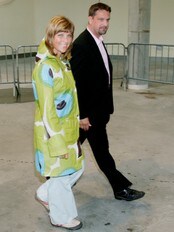
This colourful exhibition recently (14.2) opened at Kunstindustrimuseet - Museum of Decorative Arts and Design - in Oslo (see National museum of art, architecture and design).
This is the retrospective travelling exhibition of Marimekko (first exhibited in 2003, so finally now in Oslo).
More info from the museum here: http://www.nationalmuseum.no/index.php/content/view/full/6955
And here you can find an article with more photos by Marianne Siebke, for nrk: http://nrk.no/nyheter/kultur/1.6967878
Siebke has interviewed Anne Kjellberg, senior curator of the Kunstindustri museum. We get to know an interesting anecdote about the woman designer Maija Isola who later designed one of the most well-known Marimekko patterns, the interlocking poppies (valmuer in Norwegian). Maija Isola had lived in Oslo, where she worked at the restaurant Gamle Raadhus (old townhall). She also visited the Kunstindustri museum and was inspired by old jugs to draw the pattern "Amfora".
In Norwegian (excerpts from Siebke's article for nrk):
Kvinnen bak valmuemønsteret
Allerede i 1949 engasjerte de designeren Maija Isola (1927-2001). Isola hadde bodd i Oslo, der hun jobbet på restauranten Gamle Raadhus. Hun vanket på Kunstidustrimuseet, og der inspirerte gamle krukker henne til å tegne mønsteret «Amfora».
Later her famous patterns for Marimekko were used on a variety of objects such as raincoates.

Marimekko is not only an example of Finnish joyful design. It has been a huge marketing success but also experienced troubled water economically speaking as a company. For some elaboration on this, based on empirical design and management research on Marimekko, see a good chapter by Antti Ainamo (1998) in the research anthology book Management of Design Alliances (Bruce and Jevnaker, eds, published on John Wiley & Sons, UK. You will probably get it via a library).
